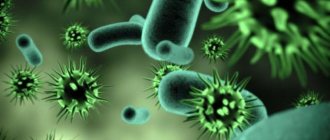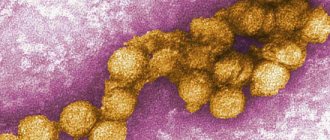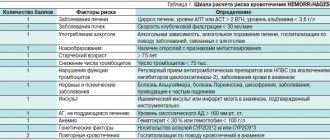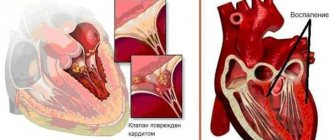Local therapist
Serebryakova
Oksana Evgenievna
Experience 27 years
Local therapist, candidate of medical sciences, member of the Russian Scientific Medical Society of Therapists
Make an appointment
The patient's condition is considered febrile if the body temperature rises above 37.2°C. This condition is not an independent disease, but is regarded as a sign of a serious pathology - an inflammatory process, infection, oncology. Less commonly, body temperature rises when taking certain medications and during heat stroke. Also, the temperature can fluctuate around the specified value during the day - decrease at night during sleep and increase in the evening due to intense exercise. For a healthy person, the range of daily fluctuations usually does not exceed 0.6°C.
Classification of fever
Depending on the level of body temperature, the following method of classifying fever is used:
- subfebrile temperature within 37.2 - 37.9°);
- febrile temperature at 38.0 – 38.9°C;
- pyretic temperature at 39.0 – 40.9 °C;
- hyperpyretic temperature starts at 41°C.
Attempts to cope with the rise in temperature are selected depending on its level. For low-grade fever, intervention is not recommended. The exception is pathology, when even a slight increase in temperature causes significant inconvenience to the patient. As the parameter increases, measures must be taken to stabilize it. Moreover, in the overwhelming majority of cases, the symptoms of fever indicate a serious problem in the body, to which it reacts by attempting to destroy the cause through high temperature or defeat it through the production of antibodies. Even if the temperature has been reduced, it is necessary to seek medical help and undergo the recommended diagnostics to clarify the cause of the fever and the immune response.
Fever. Variety of reasons and complexity of solutions
ON THE. COROVIN
, Doctor of Medical Sciences, Professor,
I.N.
ZAKHAROVA , Doctor of Medical Sciences, Professor,
E.M.
OVSYANNIKOVA , Doctor of Medical Sciences
Department of Pediatrics GBOU DPO "Russian Medical Academy of Postgraduate Education", Moscow The basics of the pathogenesis of fever are outlined.
The characteristics of fever are given according to the duration, duration, severity and aggressiveness of the fever. The features of infectious and non-infectious fever are given with the features of differential diagnosis for fever. The pathogenesis of various types of hyperthermia and their clinical features are covered. Rational tactics for observation, diagnosis and symptomatic treatment of children with fever have been determined. The issues of optimal selection and rational use of antipyretics in pediatric practice are considered. Fever is an adaptive reaction of the body that occurs in response to exposure to pathogenic stimuli and is characterized by a restructuring of thermoregulation processes, leading to an increase in body temperature, stimulating the natural reactivity of the body [1].
Fever is fundamentally different from the normal response to excessive production or loss of heat by the body. At the same time, when body temperature increases (muscular work, overheating, etc.), the thermoregulation center remains set to normalize temperature. At the same time, during fever, thermoregulation purposefully “rearranges” the processes of heat production and heat transfer to change temperature homeostasis in the direction of increasing body temperature. In addition, during fever, temperature homeostasis switches to a higher level (“setting a new thermostat point”), which is fundamentally different from normal thermogenesis and the mechanism of activation of the thermoregulation center.
Since fever is a nonspecific protective-adaptive reaction of the body, the reasons that cause it are very diverse. There are two groups of causes of fever: infectious and non-infectious [1, 2].
Substances that enter the body from the outside or form inside it and cause fever are called pyrogenic. Exogenous pyrogens are: endotoxins of gram-negative bacteria, diphtheria bacilli and streptococci, protein substances of dysentery and paratyphoid bacilli. However, some infectious pathogens, in particular viruses, Rickettsia, spirochetes, do not have endotoxins and cause fever by stimulating the synthesis of endogenous pyrogens.
Each of the above variants of fever, despite the general mechanisms of thermoregulation disturbance, has specific features of pathogenesis and clinical picture [3]. The temperature reaction of non-infectious origin is associated with the central and peripheral action of endogenous pyrogens, hormones and mediators. The main link in the pathogenesis in this case is a decrease in heat transfer without increasing heat production.
In clinical practice, it is customary to distinguish between “pink” and “pale” fevers. With “pink” fever, the child maintains a balance between heat production and heat transfer. The child's skin is warm, moist, moderately hyperemic, the state of health is almost undisturbed, tachycardia and increased breathing correspond to body temperature, the limbs are warm, the rectal - digital gradient does not exceed 5-6 ° C, red dermographism. There is a positive reaction to antipyretics. This is a prognostically favorable variant of fever.
However, the absence of sweating in a child with pink skin and fever should raise suspicion of severe dehydration due to diarrhea, vomiting, and tachypnea.
In the case when, with an increase in body temperature, heat transfer due to a significant impairment of peripheral circulation is inadequate to heat production, the fever takes on an inadequate course. Clinically, there is a disturbance in the condition and well-being of the child, persistent chills, pale skin, acrocyanosis, cold feet and palms (“pale fever”). These clinical manifestations indicate a pathological course of fever, are prognostically unfavorable and are a direct indication of the need for emergency care.
Fever is usually assessed by the degree of increase in body temperature, the duration of the febrile period and the nature of the temperature curve [1].
Depending on the degree of temperature increase:
Subfebrile 37‚2−38‚0 °С Low febrile 38‚1−39‚0 °С High febrile 39‚1−40‚0 °С Excessive (hyperthermic) over 41‚1 °С Depending on the duration of the febrile period: Ephemeral – from several hours to several days Acute – up to 15 days Subacute – up to 45 days Chronic – over 45 days
Depending on the nature of the temperature curve:
Constant fever (febris continua) is characterized by an increase in body temperature with daily fluctuations of no more than 1 °C. Relaxing fever (febris remittens) - characterized by an increase in body temperature, in which daily temperature fluctuations exceed 1 ° C. The temperature may drop below 38 °C, but does not reach normal numbers.
Intermittent fever (febris intermittens) is a fever in which periods of normal and elevated temperatures alternate within a day. Perverted fever (febris inversa) is a fever in which there is a perversion of the daily temperature rhythm with higher temperature rises in the morning.
Wasting fever (febris hectica) is a fever characterized by a rise in body temperature to high levels with a very rapid decrease. There may be several episodes of temperature rise and fall during the day.
Abnormal fever (febris atypica) - a fever in which there are no patterns
When carrying out differential diagnosis of fever, it is necessary to pay attention to: - the duration of fever; — for the presence of specific clinical symptoms and symptom complexes that allow diagnosing the disease; — on the results of paraclinical studies.
Mandatory methods of primary examination of a patient with fever include: • thermometry at 3-5 points (in the armpits, groin areas, in the rectum); • clinical blood test; • biochemical blood test (CRP, fibrinogen, protein fractions); • general urine analysis.
Additional studies in a child with fever are carried out depending on the complaints and symptoms identified during follow-up. Depending on the duration of fever, the clinical picture of the disease and the results of additional studies, the following groups of children with fever can be distinguished [4, 5].
1) children with acute fever, in whom the corresponding symptoms and medical history allow a diagnosis to be made without the use of additional studies (childhood infections, influenza, acute respiratory viral infections, etc.); 2) children with fever without specific symptoms, in whom neither a physical examination nor anamnesis allows for a diagnosis, but traditional studies help resolve the issue of the cause of the fever and diagnose the disease (pyelonephritis, brucellosis, tuberculosis, etc.); 3) children with fever of unknown origin, when the body temperature is above 38 ° C, persists for more than 5-7 days and examinations do not allow the question of diagnosis to be resolved.
The combination of the clinical picture of the disease with laboratory parameters makes it possible to differentiate between “inflammatory” and “non-inflammatory” fever [6, 7].
Signs of “inflammatory” fever include: • connection between the onset of the disease and infection (catarrhal symptoms of the upper respiratory tract, the presence of symptoms of an infectious disease, aggravated epidemiological history), • inflammatory changes in the blood (leukocytosis, acceleration of ESR, increased levels of fibrinogen, C- reactive protein, dysproteinemia), • the presence of symptoms of intoxication, • poor health, • tachycardia and tachypnea, • relief of fever when using antipyretic drugs, • a positive effect when prescribing antibacterial drugs.
Fever in immunopathological processes has a number of features. The most persistent fever is characteristic of the allergic variant of JRA. Its features include: • its nature is intermittent, • its severity is febrile, usually with two daily peaks, • an increase in temperature is accompanied by skin rashes, • the appearance of fever can be observed long before the development of articular syndrome, lymphadenopathy and other manifestations of the disease, • a drop in temperature is accompanied by heavy sweat, • in a clinical blood test: leukocytosis with a neutrophilic shift, acceleration of ESR to 40−60 mm/hour; CRP – sharply increased, • when antibacterial therapy is prescribed, the fever does not decrease, • antipyretics give a weak and short-term effect, • the appointment of glucocorticosteroid drugs leads to normalization of temperature within 24–36 hours.
The nature of non-infectious causes of fever varies depending on the age of the child. In children of the first months of life, one should think first of all about water deficiency dehydration and hypernatremia, from the age of 6 months. up to 3 years - about allergic processes (drug fever, serum sickness, urticaria, etc.), and at school age - about endocrinological (diabetes mellitus, hypocortisolism, thyrotoxicosis) and immunopathological (diffuse connective tissue diseases, hemorrhagic vasculitis) diseases.
The signs of “non-inflammatory” fever caused by a violation of neurovegetative regulation in children are characterized by: • good tolerance of fever; • absence of chills, perhaps a feeling of “heat” during the period of rising T; • normalization of temperature at night; • temperature mapping (temperature measurement at 5 points) reveals asymmetry; • there is no adequate increase in temperature due to increased heart rate; • there is a connection with psycho-emotional influences; • temperature that decreases spontaneously, • no effect from antipyretic drugs.
Autonomic disorders accompanied by fever are most common in children of preschool and school age, especially during puberty. It is noted that periods of increased temperature are seasonal (usually autumn, winter) and can persist for several weeks.
It should be emphasized that this fever can be regarded as a consequence of autonomic imbalance only if the child is examined and its inflammatory genesis is completely excluded [9]. Antipyretic drugs are not used for fever of vegetative origin. Sedative herbal medicine is used, physical therapy, massage, acupuncture, and autogenic training have a good effect.
“Non-inflammatory” fever, the genesis of which is due to endocrine pathology (excessive formation of thyroxine and catecholamines) and drug allergies, does not require the use of antipyretics. The temperature usually normalizes when the underlying disease is treated or when the allergenic drug is discontinued.
If the fever persists for more than 3 weeks, with a temperature rise above 38 ° C without an established cause, then such a fever is called fever of unknown origin (FUO). In the work of RG Petersdorf (1961), LDL was defined as a body temperature above 38.3 ° C, persisting for more than 3 weeks. with a diagnosis that remains unclear after a one-week hospital stay. Many authors emphasize that LDL is more often caused by common diseases that occur atypically than by rare exotic diseases [6, 8, 9]. Malakhovsky V.B. et al. (1998) identify the key parameters of LDL - pyrogenicity, monosymptomaticity and relapse-freeness [6]. Cases of unclear subfebrile conditions, which require a different diagnostic approach, should not be classified as fever of unknown origin. Prolonged fever in children is most often caused by 3 categories of diseases: infectious diseases, connective tissue diseases, neoplasms [6, 7]. As the duration of fever increases, the chances of detecting infectious diseases decrease.
When determining the cause of LDL, the pediatrician should exclude [12]:
1. The presence and exacerbation of foci of chronic infection in the nasopharynx (sinusitis, tonsillitis, adenoiditis, ethmoiditis). 2. Tuberculosis, which is one of the most common causes of LDL. Prolonged fever may indicate the appearance of extrapulmonary foci of the disease. The most common extrapulmonary sites of infection are the kidneys and bones. 3. The possibility of developing endocarditis in children with congenital heart defects. 4. The debut of one of the variants of systemic vasculitis (Kawasaki disease, polyarteritis nodosa), since the latter make up about 10% of all cases of LDL. 5. Fever can be one of the manifestations of an allergic reaction to various medications, including antibacterial ones. 6. Malignant neoplasms.
Along with clinical data and the results of traditional laboratory tests, additional studies are required to identify the possible cause of LDL.
The range of additional studies to determine the genesis of fever includes the following laboratory and instrumental studies:
• microbiological examination of blood, urine, oropharyngeal smear to identify the pathogen, including fungal microorganisms and acid-fast ones; • isolation of viruses from urine, blood plasma, nasopharyngeal mucus, its DNA, antibody titers; • comprehensive examination of the patient for tuberculosis; • tuberculin skin test (almost always negative in cases of vigorous or acute infection, it should be repeated after 2 weeks); • HIV antibody test; • electrophoresis of serum proteins in case of suspected pathology of the immune system; • echocardiography; • chest x-ray; • CT/MRI of the abdomen and pelvis; • radioisotope scanning (in combination with direct biopsy if indicated) if an infectious process or mass formation is suspected; • microscopy of thick blood smear; • antinuclear factor, LE cells; • study of thyroid function if thyroiditis is suspected; • bone marrow puncture; • scintigraphy of skeletal bones. Dencitometry; • Ultrasound of the abdominal cavity and pelvic organs (in combination with a biopsy if indicated) if a mass formation, obstructive kidney disease or pathology of the gallbladder and biliary tract is suspected; • echocardiography for suspected valve damage, atrial myxoma, pericardial effusion; • endoscopic and morphobioptic gastrointestinal tract. Additional studies • Bone marrow puncture for suspected granulomatosis, malignant neoplasms • Liver biopsy for suspected granulomatosis • Temporal artery biopsy for suspected giant cell arteritis • Biopsy of lymph nodes, muscles and skin (according to indications) • If the diagnostic procedures performed turned out to be uninformative, carry out diagnostic laparotomy.
Among patients with LDL, there are patients in whom, despite a thorough examination, the diagnosis cannot be verified. The frequency of fevers undeciphered after examination varies, according to various sources, from 5 to 26% and is apparently determined by a number of factors (features and nature of the disease, level of examination, adequacy and information content of the methods used, etc.). It is believed that about 90% of all cases of LDL should be decipherable [8]. According to follow-up data, in some cases the fever disappears spontaneously and does not recur in the future. Most likely, in such situations we are talking about various infectious and inflammatory diseases, which for many reasons have not been verified. It is possible that some patients experienced spontaneous recovery from TBC [8].
Such a cure is less likely in patients with unrecognized tumors or systemic vasculitis. You should remember the existence of the so-called. periodic fevers with a long fever-free period.
In this case, a relapse of fever can occur after a long period of time and is regarded by the doctor as a new disease. In some cases, making a diagnosis for undeciphered fevers becomes possible only after long-term observation of patients, when some additional signs appear. Therefore, patients with undeciphered LDL are subject to careful dynamic monitoring. If the cause of the fever remains unclear, then this must be reflected in the medical documents. In such situations, the diagnosis of LDL, paradoxically, is more justified than such artificially fabricated diagnoses as pneumonia, chronic pyelonephritis and a number of others.
Principles of fever treatment
First of all, it is necessary to find out the cause of the increase in body temperature and determine whether the child needs emergency care. Anamnesis data allows us to determine whether for a given child fever is a risk factor for the development of serious complications, etc. Depending on a detailed analysis of clinical and anamnestic data, an individual observation strategy and rational therapeutic tactics are selected in each specific case.
For a differentiated choice of antipyretic drugs in children, it is advisable to distinguish 2 observation groups - initially healthy and a “risk group for the development of complications.”
Risk group for the development of complications during fever: • child's age up to 2 months. life in the presence of a temperature above 38 °C • history of febrile convulsions • diseases of the central nervous system • chronic pathology of the circulatory system • hereditary metabolic diseases
Treatment of fever is symptomatic and is determined by the age, somatic status of the child, its intensity, and includes a combination of physical and chemical methods. It should be remembered that fever is not a disease, but its manifestation, a physiological reaction aimed at fighting infection. Fever inhibits the growth and reproduction of bacteria and viruses, accelerates the production of neutrophils and the proliferation of T-lymphocytes.
The main goal of treating fever is to restore the patient’s comfort (first of all), because at high temperatures the child becomes lethargic or restless, refuses to eat and drink, which, against the background of increased fluid loss during hyperthermia, leads to dehydration. And only secondarily – prevention of hyperthermic tissue damage (at temperatures above 40–41 °C). The risk of lowering the temperature lies in masking the symptoms of the disease, prolonging the time for diagnosing the disease, and delaying treatment [10].
Antipyretics should not be prescribed for regular, course use, regardless of the temperature level. With this prescription, the true temperature curve is sharply distorted, which makes it difficult to identify the causes of fever or assess the course of the pathological process. Particular care must be taken when prescribing antipyretics to children receiving antibiotics, since it is difficult to assess the effectiveness of the latter.
An increase in temperature above 40 °C causes brain damage, which, if antipyretics are abandoned, will provoke a further increase in temperature [11]. Rubbing is indicated when the temperature rises to 41.0 °C or higher, febrile convulsions. Rubbing should be done with slightly lukewarm water, and in no case with alcohol. Cold water causes discomfort; fear and crying of a child can aggravate a cold. An antipyretic should be given 30 minutes before rubbing. If you rub down without first prescribing an antipyretic, you may experience chills and trembling, which in itself leads to an increase in body temperature.
A feverish child should drink more than a healthy child. An increase in body temperature causes increased evaporation of fluid from the mucous membranes of the respiratory tract and from the skin. For every degree increase in body temperature above 37.5 °C, the child should receive fluids of 5 ml/kg/day [12].
Acetylsalicylic acid (ASA) is not indicated for young children, for viral diseases and especially for influenza, influenza-like illnesses and chickenpox. While taking ASA, Reye's syndrome may develop [13].
Until recently, only ibuprofen and paracetamol fully met the criteria of high efficiency and safety and were officially recommended by the World Health Organization and national programs in pediatric practice as antipyretics [14, 15]. When choosing an antipyretic drug for a child, it is necessary, first of all, to take into account not only the effectiveness and safety of the drug, but also pay attention to the convenience of its use, the availability of various children's dosage forms for different age groups.
Acetaminophen (paracetamol) is a non-selective blocker of cyclooxygenase types 1 and 2. Acetaminophen is indicated when the child's temperature rises above 39°C or if the child is unwell at a lower temperature. Acetaminophen can be given every 4–6 hours and lowers the temperature by 1–2°C over 2 hours. The most common adverse reaction is hepatotoxicity, especially if the dose is overdose.
Ibuprofen is considered the drug of choice for the treatment of fever in children. It lasts significantly longer than acetaminophen (6–8 hours vs. 4–5 hours). According to a meta-analysis, the immediate analgesic and antipyretic effect of taking ibuprofen (4–10 mg/kg) and acetaminophen (7–15 mg/kg) is almost the same, but 2, 4 and 6 hours after administration, the antipyretic effect of ibuprofen is more pronounced. The effectiveness of ibuprofen, according to the results of many studies, is higher than paracetamol [14].
Ibuprofen reduces temperature more effectively than other antipyretics [14, 15], maintains a lower temperature longer and is prescribed less frequently, which is important in pediatric practice. Ibuprofen, a cyclooxygenase blocker, is prescribed at a dose of 6–10 mg/kg/day (20–40 mg/kg/day). It is especially effective in infections with a pronounced inflammatory component and in cases with a pain reaction. The drug reduces vascular permeability, improves microcirculation, reduces the release of inflammatory mediators from cells and suppresses its energy supply.
Currently, the arsenal of antipyretic drugs includes Ibuklin Junior® (Registration number P No. 11252/02) - a combination drug, the effect of which is due to the components of ibuprofen and paracetamol. The effectiveness of this drug in combination is higher than the individual components. This is a combination of a rapid and long-lasting antipyretic effect with analgesic and anti-inflammatory effects.
The results of a multicenter study on the dynamics of fever and pain when prescribing Ibuklin proved that in patients with fever, the ibuprofen/paracetamol combination after the first dose has a pronounced antipyretic effect, which increases after the second and third doses of the drug during the first day of observation, and from the second day of treatment reliably exceeds similar effects of single drugs. In patients with pain syndrome, the combination of ibuprofen/paracetamol after the first dose demonstrates a pronounced analgesic effect, which lasts slightly longer than that of single drugs and increases after the second and third doses during the first day, and from the third day of treatment it becomes stable and significantly exceeds similar indicators of single drugs . According to the authors, this combination can be considered as a first-line agent for symptomatic and pathogenetic treatment of fever and pain syndrome of various origins in outpatient practice [16].
Ibuklin Junior® can be recommended for high fever combined with bone, joint and muscle pain. The drug is recommended for children from 3 years of age as an antipyretic no more than 3 times a day, an analgesic for up to 5 days, frequency of use for children from 3 to 6 years old: 1 tablet 3 times a day, from 6 to 12 children - up to 2 tablets 3 times a day.
Most often, antipyretics are used in pediatrics in the form of syrups and suspensions. Ibuklin Junior® is available in the form of dispersible tablets. It is enough to dissolve the tablet in 5 ml of water before taking.
In some cases, for example, with nausea, vomiting, or a child’s refusal to take oral medications, it is necessary to resort to alternative routes of drug administration - parenteral, rectal. Unlike injections, rectal suppositories are a convenient and quite comfortable method of drug delivery for a child. Very often, suppositories are used in combination therapy: during the day the patient receives tablets or a suspension, and at night - suppositories, which creates a more uniform and long-lasting concentration of the drug in the blood.
Conclusion
Thus, for inflammatory fever in children, only safe antipyretic drugs should be used, which include paracetamol, ibuprofen or a combination thereof. The prescription of antipyretics for low-grade fever is indicated only for children at risk. The use of antipyretic drugs is contraindicated for “non-inflammatory fevers” (central, neurohumoral, reflex, metabolic). Rational use of antipyretic drugs will minimize the risk of developing their side and undesirable effects.
Bibliography:
1. Korovina N.A., Zaplatnikov A.L., Zakharova I.N. Fever in children: Differential diagnosis, therapeutic tactics. Educational and methodological manual for doctors. M., 2006. 66 p. 2. Ilunina L.M. Feverish conditions in children: methodological recommendations / L.M. Ilunina, S.P. Kokoreva, A.V. Makarova. Voronezh: VSMA, 2008. 32 p. 3. Khaitov R.M., Ignatieva G.A. Immunology. M.: Medicine, 2000. 432 p. 4. Mazurin A.V., Vorontsov I.M. Propaedeutics of childhood diseases. 2nd ed., add. St. Petersburg: Farmetekh, 2009. 926 p. 5. Tatochenko V.K. Modern approaches to the treatment of fever in children with infectious pathology. Attending Physician, 2008; 8:8. 6. Malakhovsky V.B. Approaches to the diagnosis of fever of unknown origin in children. Pediatrics, 1998; 5:61-63. 7. Hay W, Hayward A, Lewin M (Eds). Current pediatric diagnosis and treatment. 16th ed. McGraw Hill, New York, 2003; 237-9. 8. Didkovsky N.A., Dvoretsky L.I. About fevers of unknown origin in the practice of a therapist. Sov. Med., 1980; 9:65-70. 9. Algorithm: Fever of unknown origin (ed. article). Consilium medicum, 2001. 10. Tatochenko V.K. Rational use of antipyretics in children. RMJ, 2000; T. 8, 3-4:40-42. 11. Algorithm: Fever of unknown origin (ed. article). Consilium medicum, 2001; T. 3,9:404-407. 12. Walsh A, Edwards H, Fraser J. Over-the-counter medications use for childhood fever: a cross-sectional study of Australian parents. J Pediatr Child Health 2007; 43:601-6. 13. Morrey J.P. (Morray JP). Reye's syndrome. Intensive care in pediatrics. In 2 vols.: / per. from English; edited by J.P. Morrey. M.: Medicine, 1995. T. 1:376-388. 14. Vinh H, Parry C, Hangh V, et al. Double blend comparison of ibuprofen and paracetamol for adjunctive treatment of uncomplicated typhoid fever. Pediatr Infect Dis J 2004; 23:226-30. 15. State register of medicines. M.: Ministry of Health of the Russian Federation, 2010. 16. Baranova L.N., Kupryashina N.V., Mazurenko D.V. Pharmateka, 2012; 1:51-57.
Symptoms
With a slight increase in temperature, a person does not feel any discomfort and continues to lead his usual lifestyle. Rarely, there may be a feeling of discomfort due to temperature differences and a feeling of heaviness in the head area. When the temperature rises to 38.0 °C or more, characteristic “feverish” symptoms appear:
- redness of the skin of the face and body;
- inflamed eyes, caused by increased tear production;
- intense sweating associated with the body’s attempt to reduce the increased temperature;
- headache;
- aches in muscles and joints;
- decreased appetite;
- rapid breathing;
- drowsiness, immobility.
Children may experience a different course of the febrile process. “Red” fever is characterized by a slight deterioration in the condition, maintaining a comfortable temperature of the extremities and relatively stable health. With “white” fever, the child becomes lethargic, his skin turns pale and acquires a bluish tint, the pulse becomes faster, and blood pressure is higher.
Medicines
Photo: lecheniebolezney.com
In the treatment of fever, non-steroidal anti-inflammatory drugs (NSAIDs) are used, which have antipyretic, anti-inflammatory and analgesic effects. To reduce fever, preference is given to drugs with a pronounced antipyretic effect.
These include:
- Paracetamol. A drug with a pronounced antipyretic effect, due to which the temperature decreases. It is well tolerated by both children and adults, and is therefore often prescribed for the treatment of fever. But it is important to remember that long-term use of paracetamol in large doses has a toxic effect on the liver. Therefore, before taking the drug, you should consult your doctor and ensure that you do not exceed the maximum recommended dose. Paracetamol is included in many powders (Theraflu, ORVIcold, Fervex, etc.).
- Aspirin. It still remains relevant due to its low cost and low toxicity. But it is important to remember that in children under 12 years of age, aspirin is contraindicated due to the possibility of developing Reye's syndrome. This syndrome is characterized by severe encephalopathy and toxic liver damage, often leading to death.
- Ibuprofen. Available in the form of tablets, syrup, suspension, rectal suppositories. It is used in both adults and children. It has moderate antipyretic, anti-inflammatory and analgesic effects. There is evidence that ibuprofen is able to stimulate the immune system and increase the body's protective properties by influencing the production of endogenous interferon. In the treatment of fever it is inferior to paracetamol, therefore it is a second-line drug.
Since all NSAIDs are, to a greater or lesser extent, capable of affecting the mucous membrane of the gastrointestinal tract with the further development of gastritis and peptic ulcers, it is recommended to take drugs in this group exclusively after meals.
Diagnostics
You can check your body temperature by measuring it with a mercury or electronic medical thermometer. It is placed in the armpit so that the shoulder fits tightly to the chest and a sealed space is maintained inside the armpit. In children and weakened patients, the hand with the thermometer should be held. The measurement duration is about 10 minutes. When assessing the actual indicator, you should focus on the level of 36.4-37.2 ° C - a temperature in the specified range is considered normal.
When measuring temperature in young children, use a special rectal thermometer designed to measure body temperature through the anus. However, this method has several contraindications. These are anal fissures, pronounced hemorrhoids and inflammation of the rectum, which excludes any additional trauma to the mucous membrane. The measurement is taken with the patient positioned on his side, with his knees pressed to his chest. The thermometer is inserted into the anus so that the measuring tip goes completely inside. To obtain the desired parameter, 2-3 minutes are enough, and the range of 37.1–37.9 ° C is considered normal.
An oral method of measuring temperature, for which a safe electronic thermometer is used, is considered acceptable. The normal variant here is the range of 36.7 -37.4°C. However, the data may be distorted due to the patient's recent consumption of hot or cold foods and drinks.
Establishing the fact of a febrile state is only part of the diagnostic measures. The doctor needs to find out what caused the increase in body temperature. For a more precise diagnosis of fever, the patient is referred to:
- radiography;
- ultrasonography;
- blood and urine tests;
- other diagnostic procedures.
If the temperature is low
It happens that with ARVI, the thermometer freezes at below 360C. How to feel about this and what to do? Hypothermia can be caused by excessive sweating. You need to wipe your armpit dry and measure your temperature again. A temperature reaction that is inadequate to the general condition often occurs in older people, pregnant women, and patients with severe concomitant diseases and endocrine pathologies. Sometimes the cause of hypothermia is the abuse of antipyretic drugs, so you should always strictly follow the instructions for taking the drug. Even if the temperature is normal, you should not ignore the symptoms of ARVI: the less nasal congestion and the less frequent sneezing, the less viruses will spread. The combined drug TheraFlu for colds and flu has antipyretic, anti-inflammatory, decongestant, analgesic and antiallergic effects, which helps improve well-being5 even at normal and low body temperature. In any case, if cold symptoms appear, you should consult a doctor. After all, only a specialist can adequately assess the condition and symptoms of the disease and select the necessary treatment.
Treatment options for fever
Stabilization of body temperature and treatment of fever is carried out using the following methods:
- Taking antipyretic medications. This could be paracetamol, aspirin (contraindicated in children under 12 years of age), ibuprofen tablets or syrup. The advantages of the liquid composition are the possibility of its precise dosage and ease of swallowing, which is especially important for children. It is possible to take powders containing the listed antipyretic substances, which simultaneously have an analgesic and anti-inflammatory effect.
- Compliance with bed rest, due to which the patient’s condition improves somewhat.
- Reviewing your diet in favor of frequent small meals. Priority is given to dishes with a liquid or puree consistency, the digestion of which causes the body to spend less energy. You should completely exclude the use of hot and spicy dishes, seasonings and salty foods that draw water from the body.
- Drink plenty of fluids to prevent dehydration.
- Taking medications to treat the underlying cause of the fever. These could be antibiotics, non-steroidal anti-inflammatory drugs, etc.
If the temperature rises after heat stroke, measures should be taken to reduce it. For this, the patient is wiped with cool water, given plenty of clean water to drink, covered with ice packs and wrapped in wraps.
General characteristics of the condition
Modern medicine has long ceased to classify fever as a disease. Now it is a symptom, a non-specific process in which the body temperature rises above 37 °C. This is possible due to pyrogens - cells of immune or leukocyte origin that affect the thermoregulation system. Why did evolution provide fever? High temperature helps the body fight infection more effectively, enhances the absorption of foreign particles by protective cells, and stimulates the production of interferon and antibodies.
Content:
- General characteristics of the condition
- Fever of unknown origin
- Mechanism of development and stages of fever
- How to get rid of fever?
- Possible complications
Fever does not affect the basic mechanisms of thermoregulation. Otherwise, the body would have to simultaneously resist infection and try to normalize heat transfer, and this requires enormous energy expenditure.
What conditions cause fever? An increase in temperature is possible not only during infection and active fight against infection. Possible causes include: mechanical damage and trauma, dehydration, heat stroke, exacerbation of a number of chronic diseases, myocardial infarction, tuberculosis, and some types of oncological pathologies. Fever can also be a symptom of an allergy to medications.
Diagnosis and treatment of fever at the clinic of JSC "Medicine" in Moscow
If signs of fever persist for several days without other visible symptoms, it is recommended to stop self-medicating and seek medical help. You can get it at the clinic of JSC "Medicine" in the Central Administrative District of Moscow, which has its own diagnostic center and outpatient clinic for undergoing prescribed procedures. Patients of the clinic invariably receive attentive attention, the opportunity to save time and money on undergoing research, as well as a guarantee of the security and confidentiality of personal information. Appointments can be made by phone or on the center's website.
Literature
1. N.V. Orlova, T.G. Suranova. Acute respiratory diseases: clinical features, drug therapy. MEDICAL COUNCIL • No. 15, 2021. pp. 82-88. 2. V.M. Delyagin. Fever (new touches on an ancient painting). Consilium Medicum. Pediatrics. (App.) 2018; 2: pp. 89-93 3. Dvoretsky L.I. Feverish patient. Place and benefits of antipyretics. "RMZh" No. 19 dated 09/07/2011. P. 1166 4. Martynov, A., Malyavin, A., Zhuravleva, M., Bolieva, L., Esaulenko, E., Babak, S., Kalyuzhin, O. Consensus of the expert council of the RNMOT “Improving the results of treatment of respiratory tract infections » Preventive Medicine, 2021, 22(4);144-151 5. Instructions for medical use of the drug TheraFlu® for flu and colds. RU P N012063/01 dated 05/31/2011 6. Tatochenko V.K. Use of antipyretics in children. Issues of modern pediatrics. 2004, volume 3, no. 5, pp. 70-73. 7. Melnikova I.M., Mizernitsky Yu.L. Rational use of antipyretics for acute respiratory diseases in children // Medical Council - No. 2, 2021 - P. 77-81. The trademark belongs to or is used by the GlaxoSmithKline Group of Companies JSC GlaxoSmithKline Healthcare, Russia, 123112, Moscow, Presnenskaya nab., 10, premises III, room 9, floor 6,.
Consequences and complications
Having a hyperpyretic temperature is dangerous for a number of reasons. The most basic of them are given below.
- If the temperature reaches and exceeds 42 degrees Celsius, then the protein in the body begins to coagulate. Protein performs many functions and plays a vital role in metabolic processes. Therefore, an indicator of 42 degrees threatens death.
- Blood viscosity increases as the body heats up. At excessively elevated temperatures, blood elements tend to stick together. Too viscous blood provokes an increase in blood pressure, since it is difficult for it to move through the vessels.
- Dehydration that occurs as a consequence of hyperpyrexia leads to disruption of water-electrolyte balance and metabolism.
- Intracellular gas exchange and the process of oxygen breakdown malfunction.
- Multiple small cell hemorrhages are observed in the patient’s internal organs.
- A patient in a state of hyperpyretic fever loses adequate perception of what is happening, his consciousness is confused, and the body is in a daze.
- There is a threat of hyperpyretic coma - a critical condition in which the patient loses consciousness and does not regain consciousness.
- In especially severe cases, swelling of vital organs, dystrophy of the heart muscle, and death of cells of the nervous system may occur.
In other articles on the website temperaturka.com you can learn about what febrile and pyretic human body temperatures are.
What is hyperpyretic temperature
Hyperpyrexia (excessive or hyperpyretic fever) is an extremely high temperature for the human body. Body temperature with hyperpyretic fever is 41 degrees Celsius or higher. This is a critical point for our body. It is believed that with this indicator the person is in an emergency condition: he urgently requires qualified medical care.
Hyperpyretic fever is often confused with hyperthermia (overheating of the body), but there is a significant difference between these terms. In hyperpyrexia (excessive fever), critical heating of the body is caused by a primary pyrogen, a substance that increases the body's temperature. And in a state of hyperthermia (i.e. overheating), a person is under the influence of environmental factors, when isolated from which the thermometer readings will soon return to normal.
Excessive fever is a clear sign of a pathological process in the body, due to which the body is no longer capable of self-defense, and various disturbances occur in the transmission of nerve impulses.
The mechanisms of occurrence of pyretic (from 39 to 41 degrees) and hyperpyretic (41 degrees and above) temperatures are similar. However, with hyperpyretic fever, irreversible processes occur in the human body. Malfunctions in the functioning of the peripheral nervous system lead to disorders in the functioning of the central nervous system, which are life-threatening. They can cause cessation of breathing, and protein denaturation leads to the body’s temperature being out of control of the thermoregulatory centers.
How to reduce hyperpyretic temperature
If you suspect an excessively high fever in a patient, the first thing to do is to use a thermometer to assess the threat to health. If the mark on the thermometer is 41 degrees or higher, then the following measures should be taken:
- Call an ambulance. In this case, a patient of any age will need a qualified physician, but a special risk group is the elderly, pregnant women, and children.
- While the ambulance is on the way, or if it is not possible to call a doctor, you can help the patient in one or more of the following ways:
- give an antipyretic medicine (be especially careful when calculating the dosage, take into account the patient’s age and weight);
- place the patient horizontally, isolating him, if possible, from environmental irritants;
- If a person begins to have convulsions, then turn him on his side and ease his breathing by throwing his head back. If necessary, stick out and fix your tongue;
- if possible, ensure that the room where the patient is located has a comfortable temperature and air humidity (20 degrees Celsius, 50% humidity);
- when there is no way to stabilize the temperature, try to help the patient with thermoregulation: apply cold to places of increased blood circulation - forehead, calves, neck, wrists, armpits;
- Wipe the victim with warm water and ensure a regular supply of fresh air: as the water evaporates, it will cool the body well.
Carry out the above steps until the temperature drops by at least 2 degrees, or until an ambulance arrives.
Causes of hyperpyretic temperature
In order for the temperature to exceed 41 degrees, serious reasons are needed. Common prerequisites for body heating to dangerously high levels are:
- an advanced process during acute viral infections (popular diseases characterized by hyperpyretic fever include chickenpox, hepatitis, influenza, roseola infantile, infection with rota or enterovirus);
- diseases provoked by microorganisms of bacterial origin (examples may be severe sore throat, otitis media, meningitis or pneumonia);
- poisoning with food or drinks, accompanied by an acute reaction of the digestive system and the whole body;
- heat stroke (when the patient was in the heat for a long time);
- a state of septic shock, which is a consequence of an infectious lesion of the body;
- inflammation, the source of which is localized in the peritoneum (for example, inflammation of the appendix);
- damage to soft tissues and, as a result, accumulation of pus;
- injuries to the spinal cord or brain, in which the functioning of the nervous system is disrupted or the thermoregulation centers of the body are damaged;
- severe non-food poisoning (caused by pesticides or improper use of medications);
- a consequence of the body’s reaction to someone else’s blood during transfusion;
- conducting various studies using radio waves.
Also quite common causes of hyperpyrexia are intracranial hemorrhage or the appearance of a malignant neoplasm in the brain tissue. If, under the influence of these factors, damage occurs to the brain areas responsible for thermoregulation of the body, the possibility of the appearance of hyperpyretic temperature increases.








